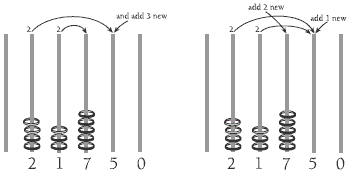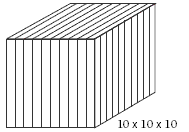This is a level 3 number activity from the Figure It Out series. It relates to Stage 6 of the Number Framework.
A PDF of the student activity is included.
Click on the image to enlarge it. Click again to close. Download PDF (297 KB)
explore place value with abacus and place value blocks
1 or 2 abacuses
FIO, Level 3-4, Number, Book 1, Places to go, page 2
Place value blocks
Activity One
The abacus is a physical model of place value and is a useful way to build on students’ understanding of place value.
Each stem on an abacus is the same as a place value column. This is marked on the students’ book: moving from the right to the left, there is the ones stem, the tens stem, the hundreds stem, and so on. When a number is multiplied by 10, all the rings on the abacus (or all the digits in the place value columns) have to move one place to the left. This means that there will be no rings left on the tens stem, so all these rings will need to be removed. That leaves one other ring for the students to move to change the number to 43 500. There are various ways of moving the rings to get the right
answer. Two ways are shown in the Answers.
Question c can be solved by halving the number (43 500 ÷ 2 = 21 750) and then working out how to get this on the abacus. This question reinforces the students’ understanding of place value.
Some students may prefer to have two sets of abacuses. They move the rings on one abacus but leave the other with the original set-up to check against.
As an extension, the students could try to find numbers on the abacus that can be halved and still use exactly the same number of rings. (The sums of the digits must be the same for the number and its half.)
For example, for the lowest four-digit number for which this is true (1 008):
1 + 0 + 0 + 8 = 9 rings. 1 008 ÷ 2 is 5 + 0 + 4 = 9 rings.
Activity Two
You may need to discuss with the students the fact that the “10” block is 10 times the size of the “one” – that is, multiplying by 10, not adding 9.
Discuss how you could make a block of 1 000. The most efficient way is to use 10 of the “100” block, either to make a long, thin block or, more conventionally, to make a cube (10 x 10 x 10).
If 1 centimetre cubes are used, the students can make the connection that 100 centimetres x 100 centimetres x 100 centimetres is the same as 1 cubic metre. The students may not have a concept of the size of a metre cube. You could ask them to make one up. One easy way of doing this is shown in Measurement, Figure It Out, Level 3, page 15.
Question 2 provides a good opportunity to discuss sensible answers and safety issues when investigating suggested measurements for a swimming pool.
“Would it be sensible to have a pool that is 10 centimetres deep or one that is 1 000 centimetres deep?”
“Would you have a pool that is 10 000 centimetres long and only 100 centimetres deep?”
Discuss whether the units of measurement are likely to be centimetres or metres.
Answers to Activities
Activity One
a. 4 350
b. The new number is 43 500. Two ways of doing this are:
c. The number is now 21 750.
Two ways of doing this are:
Activity Two
1. a. 10 x 10 x 10 or 100 x 10 x 1
b. 100 x 100 x 10 or 1 000 x 10 x 10 or 1 000 x 100 x 1
c. 100 x 100 x 100 or 1 000 x 100 x 10 or 1 000 x 1 000 x 1
2. Possible answers include: 1 000 x 1 000 x 1 000, 10 000 x 1 000 x 100, or 100 000 x 1 000 x 10. (In real terms, the possible measurements of a swimming pool would depend on whether the measurements were in cm or m.)



